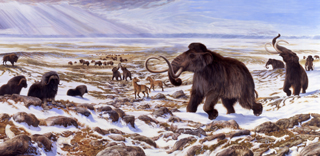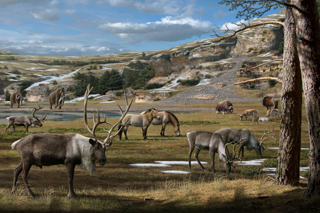
The study, published in the journal Nature, shows that both climate change and humans are responsible for the mass extinctions of large mammals – called megafauna – 50,000 years ago.
An extensive interdisciplinary research team, involving over 40 academic institutions around the world, studied the extinction of six Ice Age mammals and found that the impacts of climate change and humans had dramatically different consequences for each species.
“We found that the large mammals who went extinct in the Ice Age were strongly influenced by changes in climate and habitat, which raises concerns about the impact of future climate change on modern large animal species”, said Dr Simon Ho, from the University of Sydney’s School of Biological Sciences.
For decades, scientists have been debating the reasons behind the enigmatic mass extinctions of the Late Quaternary period, which caused the loss of a third of the large mammal species in Eurasia, two thirds of the species in North America, and nearly 90 percent of the large mammal and bird species in Australia. In particular, the roles played by climate and humans in driving the extinction have remained contentious.
To disentangle the processes underlying megafaunal extinction, the researchers combined information from ancient DNA, climate data, and the archaeological record to examine the extinction of six herbivorous mammals – woolly rhinoceros, woolly mammoth, wild horse, reindeer, bison and musk ox.
Results show that neither climate nor human occupation alone can explain the megafaunal extinctions of the late Quaternary, but rather that each species has responded differently to the effects of climate change, habitat shifts and human encroachment.

Eske Willerslev, from the University of Copenhagen, who led the research said: “Our findings put an end to the single-cause theories of the Ice Age extinctions, and suggests that care should be taken in making generalisations not just regarding past and present species extinctions but also those of the future; the impacts of climate change and human encroachment on species extinctions really depends on which species we’re looking at”.
Despite the unparalleled amount of data analysed in this study, the authors find no clear pattern distinguishing species that went extinct – such as the woolly rhinoceros and woolly mammoth – from those that survived – such as the wild horse in Eurasia and reindeer in North America – suggesting that it will be challenging for experts to predict how modern mammals will respond to future global climate change.
Read the scientific publication here:
Species-specific responses of Late Quaternary megafauna to climate and humans
Lorenzen, Nogués-Bravo, Orlando, Weinstock, Binladen, et al. (2011) Nature, 479: 359–364